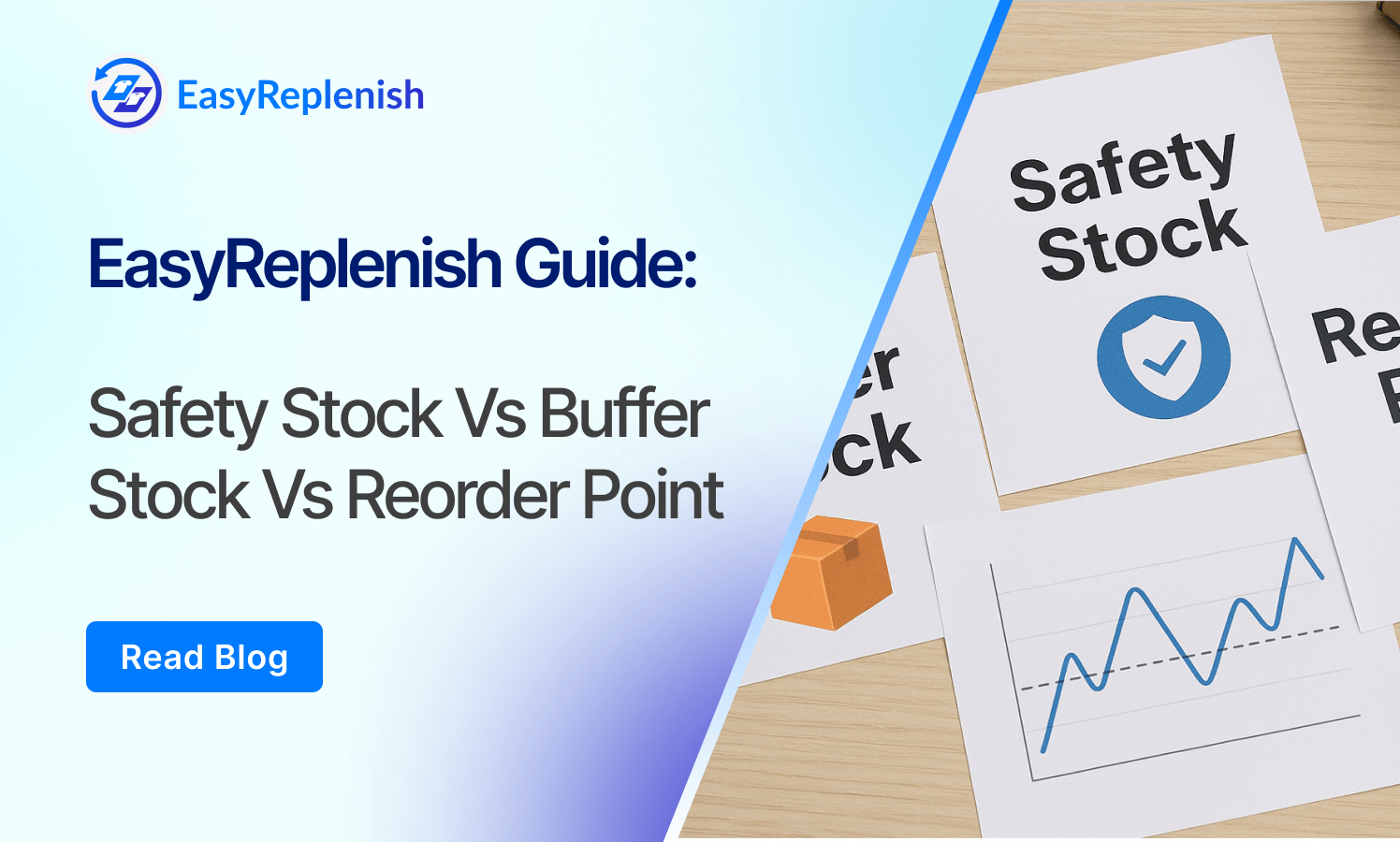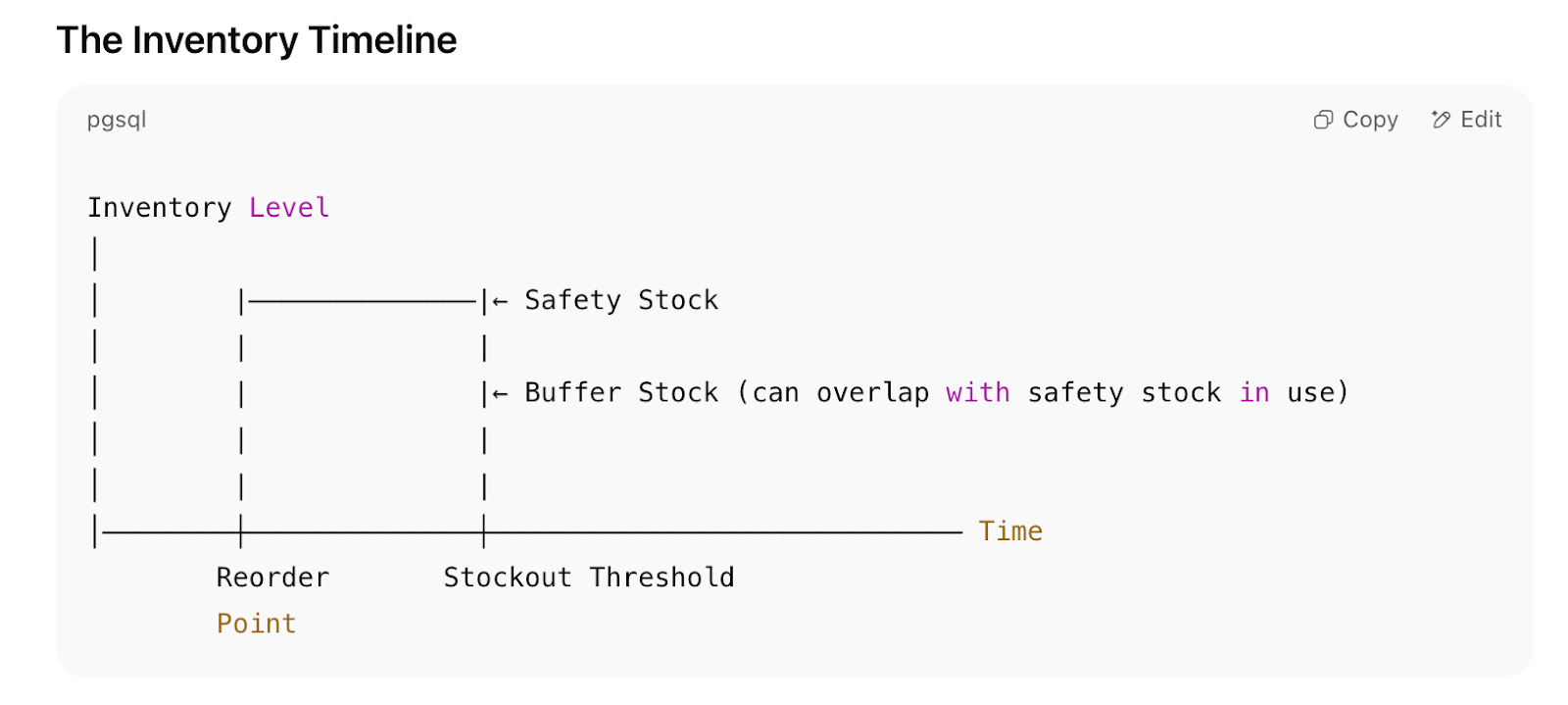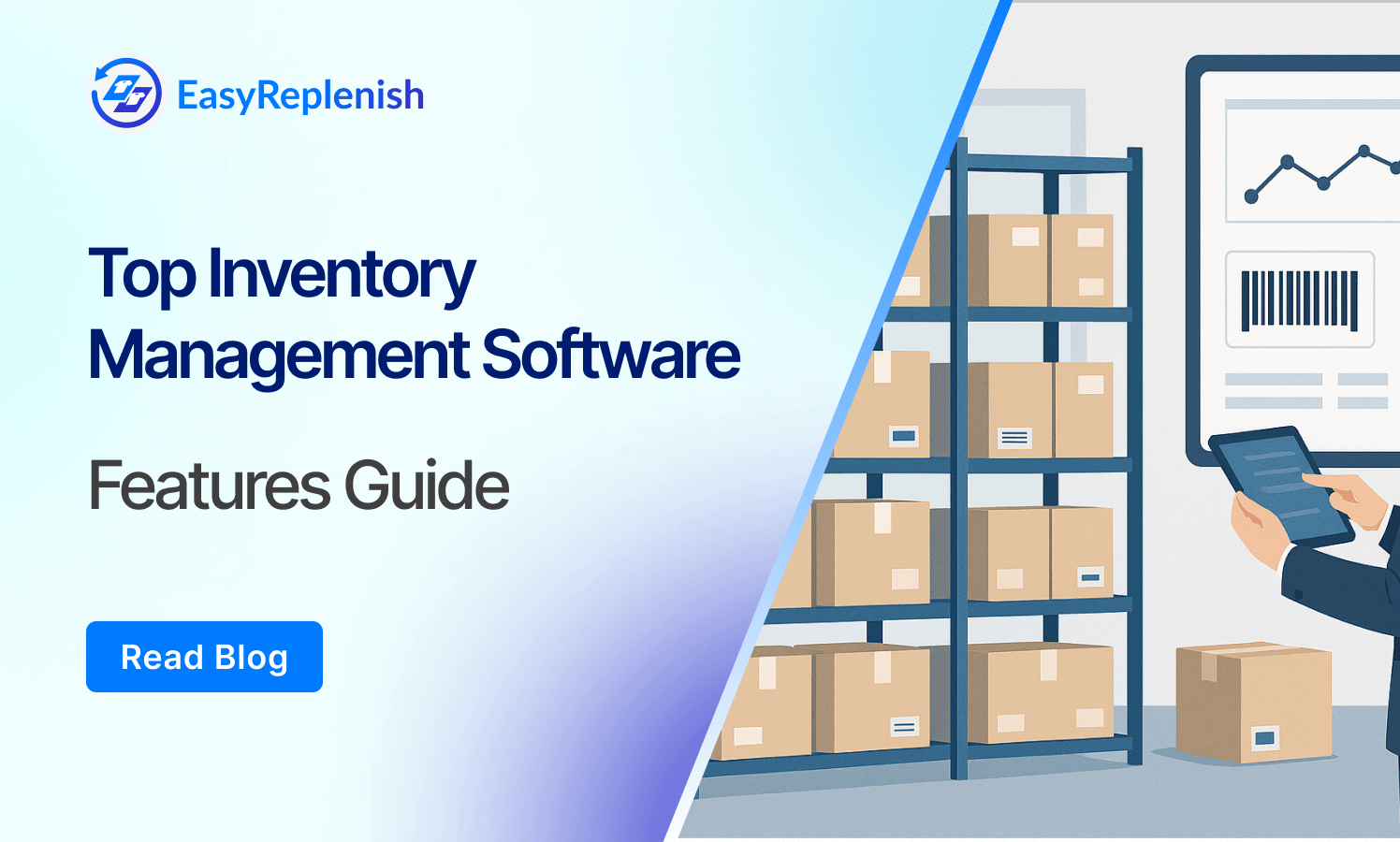EasyReplenish Guide: Safety Stock vs Buffer Stock vs Reorder Point

In inventory management, a small misstep in stock planning can spiral into lost sales, customer churn, or excess carrying costs. This is especially true when teams don’t fully understand the foundational concepts of safety stock, buffer stock, and reorder point—terms that often get used interchangeably but serve different purposes.
Whether you’re managing inventory for a fast-growing DTC brand, a retail chain, or a seasonal fashion business, having clarity on these terms is critical. They help you build guardrails against demand surges, supplier delays, and unpredictable lead times. And when applied correctly, they can significantly improve service levels, reduce working capital tied in stock, and prevent costly stockouts.
In this guide, we break down the differences between safety stock, buffer stock, and reorder point with clear definitions, formulas, and real-world examples. We’ll also show you when and how to use each one, and how modern inventory software can automate this process with accuracy and scale.
Let’s start with the basics.
Safety Stock, Buffer Stock & Reorder Point — Definitions & Differences
1. What is Safety Stock?
Safety stock is the extra inventory you hold as a cushion against unexpected spikes in demand or supplier delays. It’s your last line of defense when things don’t go as planned—like a shipment delay, a sudden influencer-driven surge in orders, or a demand forecasting error.
This is especially important for fast-moving SKUs or when lead times are unpredictable. Holding safety stock prevents stockouts without overcommitting capital to excess inventory.
Formula (basic):
Safety Stock = (Maximum Daily Usage × Maximum Lead Time) - (Average Daily Usage × Average Lead Time)
Use case: A fashion retailer keeps safety stock for top-selling winter jackets in case a restock shipment from the manufacturer gets delayed due to port congestion.
2. What is Buffer Stock?
Buffer stock is often used synonymously with safety stock—but there’s a subtle distinction. While safety stock covers demand-side uncertainty, buffer stock can cover both demand and supply-side fluctuations, as well as operational inefficiencies.
In operations-heavy businesses (e.g., FMCG, pharma, or omnichannel retail), buffer stock ensures continuity even when internal processes slow down or minor supplier disruptions occur.
Key difference: Buffer stock is more of a general safeguard against all uncertainties, while safety stock is often specifically planned based on statistical risk in demand/lead time.
Use case: A cosmetics brand holds buffer stock for its primary ingredients to ensure that sudden supplier quality rejections don’t halt production.
3. What is Reorder Point?
The Reorder Point (ROP) is the inventory level at which a new purchase order should be triggered. It’s not "extra stock"—it's a trigger threshold that factors in expected lead time and consumption rate.
Reorder points help you ensure stock is replenished before you run out, especially in automated inventory systems.
Formula:
ROP = (Average Daily Usage × Lead Time) + Safety Stock
This is where safety stock comes into play. ROP includes the safety stock as part of its calculation so that you always reorder before dipping into your emergency inventory.
Use case: A DTC electronics brand sets its reorder point for wireless chargers at 150 units, knowing it sells 30 units/day and suppliers take 4 days to deliver. Safety stock is calculated to cover 2 more days of buffer.
4. Summary of Differences
How to Calculate Safety Stock, Buffer Stock & Reorder Point with Formulas & Examples
1. Safety Stock Calculation
Formula:
Safety Stock = (Maximum Daily Usage × Maximum Lead Time) – (Average Daily Usage × Average Lead Time)
This formula helps you create a buffer that accounts for worst-case supply and demand scenarios. The goal is to hold just enough stock to handle variability without overstocking.
Example:
A fashion retailer sells an average of 100 units/day of a trending denim jacket. On peak days, sales can hit 150 units. Average supplier lead time is 5 days, but delays can extend it to 8 days.
Safety Stock = (150 × 8) – (100 × 5) = 1200 – 500 = 700 units
So, the retailer should maintain 700 units of safety stock to prevent stockouts during demand spikes or supplier delays.
2. Buffer Stock Calculation
Buffer stock isn't always calculated with a fixed formula—it’s typically a percentage of regular inventory based on risk tolerance. However, a practical way to estimate it is:
Formula (simple rule of thumb):
Buffer Stock = (Average Daily Usage × Buffer Days)
Where buffer days are added days based on anticipated operational inefficiencies.
Example:
A supplement brand uses 200 kg of a key ingredient per day and wants a 3-day buffer due to variable supplier quality checks and internal QA delays.
Buffer Stock = 200 × 3 = 600 kg
The brand should keep 600 kg of buffer stock for uninterrupted production even during internal or supplier-side inefficiencies.
3. Reorder Point Calculation
Formula:
Reorder Point = (Average Daily Usage × Lead Time) + Safety Stock
This formula ensures that the reorder happens before inventory dips into the safety stock zone.
Example:
A DTC electronics brand sells 40 units of a power bank daily. Lead time is 7 days. Safety stock is already calculated at 280 units.
Reorder Point = (40 × 7) + 280 = 560 units
When inventory reaches 560 units, a new purchase order should be triggered.
When to Use Each: Safety Stock vs Buffer Stock vs Reorder Point
Understanding when to apply safety stock, buffer stock, or reorder point is essential for effective inventory planning. Each serves a unique function based on variability in demand, supply chain reliability, and operational structure.
1. Safety Stock: For Handling Demand and Lead Time Variability
Use safety stock when demand fluctuates significantly or when supplier lead times are inconsistent. It’s especially critical in industries like fashion, electronics, or fast-moving consumer goods where stockouts directly impact revenue and customer satisfaction. Safety stock protects against uncertainty, acting as a cushion when actual demand exceeds forecasts or deliveries are delayed.
Use case example:
A fashion retailer stocking limited-edition products for seasonal campaigns. They need safety stock to manage sudden surges in demand or supplier delays during peak periods.
2. Buffer Stock: For Operational Uncertainty or Internal Delays
Buffer stock is more relevant for internal delays—like QC bottlenecks, production inefficiencies, or expected employee absenteeism. It’s also used when external supply chains are generally stable but internal processes vary. Buffer stock is often more relevant for manufacturers and D2C brands with in-house operations.
Use case example:
A skincare brand producing its own formulations might keep buffer stock of key raw materials to absorb the impact of equipment downtime or slower-than-usual lab processing.
3. Reorder Point: For Systematic Restocking Trigger
Reorder point isn’t about safety—it’s the systematic trigger that tells your system or team when to reorder stock based on known demand and lead time. It includes safety stock in the calculation to avoid dipping into it unless absolutely necessary. It’s ideal for brands using automated inventory systems or ERPs.
Use case example:
A DTC brand using Shopify and a WMS sets reorder points to automatically raise PO requests when inventory reaches 560 units, ensuring continuous availability without constant manual tracking.
Visualizing the Relationship: Safety Stock vs Buffer Stock vs Reorder Point
To fully grasp how safety stock, buffer stock, and reorder point interact, let’s break them down in a timeline and inventory flow context. These terms are often used interchangeably—but each has a distinct role in the inventory lifecycle.

- Reorder Point (ROP): This is the inventory level at which a new purchase order should be triggered. It’s calculated based on average daily usage × lead time, and includes safety stock.
- Safety Stock: Acts as a cushion against unexpected demand surges or supplier delays. You dip into it only when your regular stock isn’t enough.
- Buffer Stock: Serves as protection from internal risks—like production hiccups or labor shortages—and may sometimes be separate from or overlap with safety stock.
1. Key Differences in Flow
2. Practical Tip:
Many modern ERPs and WMS platforms (like EasyReplenish or NetSuite) now calculate these dynamically based on real-time demand, seasonality, and supplier performance—eliminating guesswork and reducing excess stock.
How to Calculate Each: Formulas and Examples
Understanding the formulas behind safety stock, buffer stock, and reorder point is crucial for effective inventory planning. Let’s break each down with practical examples so you can apply them to your business with clarity.
1. How to Calculate Safety Stock
Formula:
Safety Stock = Z × σLT × √LT
Where:
- Z = Service level factor (based on desired probability of avoiding stockouts)
- σLT = Standard deviation of demand during lead time
- LT = Average lead time in days or weeks
Example:
A fashion brand wants to maintain a 95% service level (Z = 1.65). Their average daily demand is 100 units, and the standard deviation during lead time is 30 units. The lead time is 7 days.
Calculation:
Safety Stock = 1.65 × 30 × √7
≈ 1.65 × 30 × 2.65
≈ 131.175 units
So, the company should maintain around 131 units as safety stock to prevent stockouts during uncertain demand.
2. How to Calculate Buffer Stock
Buffer stock is often confused with safety stock, but it typically accounts for non-routine disruptions—such as supplier issues or sudden demand surges. While not always calculated with a fixed formula, a practical approximation method is:
Buffer Stock = (Maximum Daily Usage × Maximum Lead Time) – (Average Daily Usage × Average Lead Time)
Example:
A smartphone accessories seller experiences a maximum daily demand of 200 units and maximum supplier lead time of 10 days. On average, they sell 120 units/day and lead time is 5 days.
Calculation:
Buffer Stock = (200 × 10) – (120 × 5)
= 2000 – 600
= 1,400 units
This means the business should hold 1,400 units of buffer stock to mitigate disruption risks.
3. How to Calculate Reorder Point (ROP)
Reorder point defines when you should trigger the next purchase order.
Reorder Point = (Average Daily Usage × Lead Time) + Safety Stock
Example:
Let’s continue with the fashion brand example. Assume average daily usage is 100 units, lead time is 7 days, and safety stock is 131 units (as calculated earlier).
Calculation:
ROP = (100 × 7) + 131
= 700 + 131
= 831 units
This means when the inventory drops to 831 units, a reorder should be triggered to avoid stockouts during replenishment.
Common Mistakes to Avoid
1. Confusing Buffer Stock with Safety Stock
While both protect against variability, buffer stock covers exceptional disruptions, whereas safety stock covers routine variability. Using them interchangeably can lead to overstocking or risky understocking.
2. Relying on Static Inputs
Using outdated average demand or lead time data leads to inaccurate calculations. These inputs must be reviewed regularly to align with current operations.
3. Ignoring Lead Time Variability
Even if average demand is stable, variability in lead times can severely impact stock availability. Always factor in standard deviation, not just mean values.
Industry Examples / Use Cases in Fashion, Electronics, and FMCG
Fashion Industry
In fashion retail, demand volatility and seasonality make inventory planning complex. Brands often rely on safety stock to protect against delayed shipments or sudden spikes in demand during peak seasons like Diwali or Black Friday. For example, a D2C streetwear brand may maintain safety stock of high-demand SKUs (e.g., best-selling oversized tees or cargos) in core sizes to avoid stockouts during influencer-led campaigns. Meanwhile, buffer stock is used more tactically—like keeping extra inventory of fast-moving accessories (e.g., belts or beanies) in warehouses closer to high-demand zones, ensuring agility in restocking. Reorder points are calculated using sales velocity, especially for basics and repeat-buy items like white tees, where lead times are predictable, and restock windows are tight.
Electronics Industry
In electronics, where lead times can stretch due to complex component sourcing and import dependencies, safety stock plays a crucial role in mitigating delays from suppliers or customs. A laptop manufacturer, for instance, might hold safety stock of key components like SSDs and processors, which are critical for final assembly. Buffer stock is used to offset supply chain disruption risks from geopolitical tensions or chip shortages. Reorder points are dynamic and often tied to real-time sales analytics; for example, for items like mobile accessories, ROPs adjust based on regional purchase patterns and sales trends from e-commerce partners.
FMCG (Fast-Moving Consumer Goods)
FMCG brands operate in high-volume, fast-turnover environments. Safety stock is typically maintained at distributor or regional warehouse levels for SKUs with erratic demand (e.g., festive-pack chocolates or new product launches). Buffer stock is used during promotions or planned marketing campaigns to ensure consistent shelf availability. For example, a beverage brand may buffer additional stock at regional hubs during IPL or summer campaigns. Reorder points in FMCG are often integrated with POS data—when daily sales cross a threshold and inventory dips below the minimum stock level, the system automatically triggers replenishment orders to maintain continuity in the supply chain.
How Modern Inventory Software Automates These Functions
Manually calculating safety stock, buffer stock, and reorder points can be time-consuming and error-prone, especially when demand patterns shift frequently or when managing multiple SKUs across channels. That’s where modern inventory optimization software steps in—bringing automation, accuracy, and speed to the entire process.
Today's intelligent inventory systems use real-time sales data, historical demand trends, supplier lead times, and even external factors like seasonality or market fluctuations to automate the calculation of safety stock and reorder points. These tools continuously update thresholds based on current stock levels and demand variability, ensuring that businesses avoid both overstocking and stockouts. Buffer stock planning is also dynamically adjusted based on risk profiles, promotions, or supply chain disruptions.
EasyReplenish is purpose-built to solve exactly these challenges. It automates safety stock and reorder point planning using demand forecasting algorithms tailored to your business. Whether you're managing 50 SKUs or 5,000, EasyReplenish gives you full visibility and control over inventory thresholds—across locations, channels, and product categories. The platform also integrates seamlessly with ERPs, sales systems, and warehouse tools, making stock replenishment not only faster but smarter. For teams looking to scale without sacrificing inventory precision, EasyReplenish offers the automation layer that turns reactive inventory decisions into proactive, profit-driven strategies.
FAQs
How do safety stock, buffer stock, and reorder point impact stockouts and overstocking?
Each of these concepts plays a distinct role in preventing stockouts and minimizing excess inventory. Safety stock acts as a demand cushion, buffer stock protects against broader supply risks, and the reorder point ensures timely replenishment. When not balanced properly, they can either cause stockouts due to underestimation or tie up capital through overstocking.
Is buffer stock necessary if I already maintain safety stock?
Yes, in some cases. Safety stock is often calculated to cover typical demand and supply fluctuations. But if your supply chain is highly unpredictable—such as sourcing from politically unstable regions or seasonal suppliers—buffer stock offers an additional layer of protection beyond standard safety stock calculations.
Can these inventory levels be dynamic instead of fixed?
Absolutely. Static thresholds often fail in volatile or seasonal markets. Modern inventory systems like EasyReplenish allow these levels to adjust automatically based on real-time sales trends, supplier performance, or promotional events. This dynamic recalibration helps retailers avoid reactive stock management.
What happens if safety stock is set too high or too low?
Setting safety stock too high leads to excess holding costs and potential obsolescence, especially in fast-changing industries like electronics and fashion. If it's set too low, you risk stockouts, lost sales, and poor customer experience. Striking the right balance is critical, and software tools can help fine-tune this threshold continuously.
How frequently should I review and update these stock thresholds?
Ideally, monthly or quarterly depending on your industry dynamics. For fast-moving goods (FMCG or fashion), monthly reviews are crucial. For more stable demand items, quarterly might suffice. However, using software like EasyReplenish enables continuous monitoring and automated recalibration, saving time and reducing errors.
Are there industry-specific benchmarks for safety stock or reorder points?
There’s no one-size-fits-all benchmark since demand volatility, lead times, and service level targets vary by industry. For example, electronics brands might target higher safety stock due to supply chain disruption risks, while FMCG may focus on speed and turnover. Benchmarks are better developed internally based on historical data and service goals.

.png)





